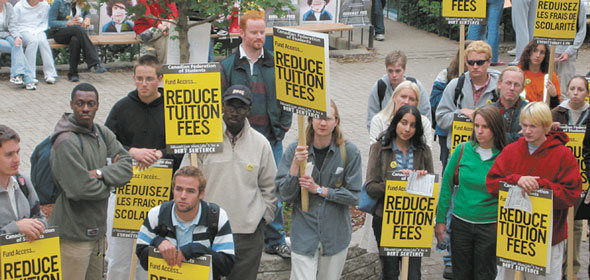Save Up, Kids: Now Even More So

A spectre is haunting post-secondary education: the spectre of deregulation. Although I wish I could continue on to say that all the Great Powers of Canada have joined together to exorcise this demon, I’d be lying, because students are essentially by themselves and isolated on this one. The fact that post-secondary education in Canada is financially wanting is not news. The news is that students, not taxes, will be footing the bill from now on. If you want, you can view this as the last stage in the commodification of education.
The history of all hitherto existing public education is one in which education has been viewed as a benefit to society and a prerequisite for progress. Furthermore, by extending education to all peoples we actually provide a benefit to all society. When education is offered to everyone, a realistic argument for class mobility can be made; an open society can be envisioned where anyone who wants to expand their intellectual horizons – and subsequently their life-chances – can do so fairly easily. But those days have now passed us. In Canada, post-secondary education is anything but equally accessible.
Deregulation of tuition fees refers to the elimination of limits surrounding the price of your post-secondary education. In Ontario, the previous Tory government implemented a 2% cap on tuition increases, which meant that schools like ours could only increase the cost of education borne by students by 2% a year. Unfortunately for universities and colleges around Ontario, this was also coupled with an increase in operating costs and cuts or freezes to the funds that they received in order to operate the institutions. So while the price of education was increasing, the amount that schools were getting from students and governments wasn’t getting any bigger.
Along came the big-fix. Some governments across Canada decided that it was acceptable for universities to charge the going-rate for some of the more expensive professional programs. Included were business, medicine, and engineering, to name a few. Graduates of these professional disciplines also happened to find jobs in fields that remunerated their workers very well, allowing a handy legitimization of the cost of the program. Who could possibly argue against charging soon-to-be-rich students a fair price for their educations?
Well, if the 137% increase in tuition fees in Ontario during the 1990s wasn’t enough to turn some potential students off, then the humongous increase to the deregulated programs definitely was. Some programs saw an increase of 300%, and currently it’s not uncommon for many deregulated business programs to charge more than $30,000 over the course of a degree. That doesn’t include any ancillary fees, or the cost of living; that’s just tuition. And, as the University of Western Ontario found out, it’s too much for some families: Admission by low-to-modest income students in their $12,000 a year medical school fell from 25% to 5% after the program deregulated its fee. The accessibility of post-secondary education for some groups in society has been dramatically affected by deregulation. And this is only the beginning. Some university administrators see it only as a matter of time before ALL programs are deregulated.
Until all students unite and realize that they have nothing to lose but their debt-chains, the market will rule, and we’ll just have to start to treat education as one of those things that some of us can get, and others will have to do without.